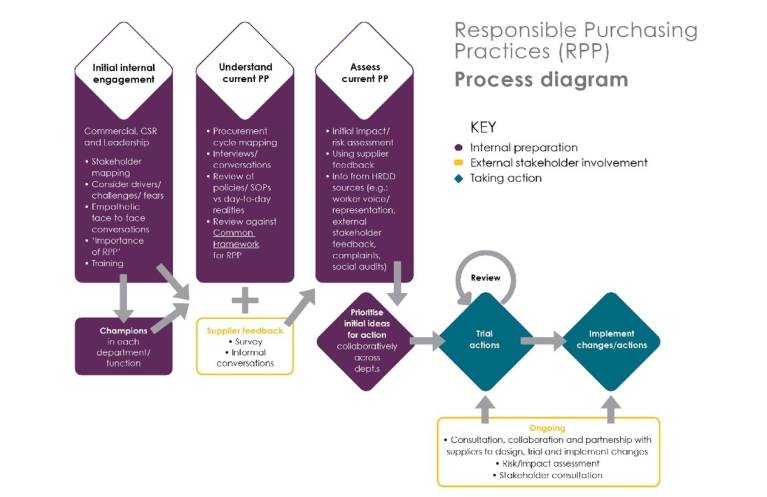Improving purchasing practices requires a collaborative approach. While individual buyers can make a significant difference, their actions are shaped by broader systems.
Industry norms, company strategy, and decisions made by other functions like legal and finance, all influence buyer-supplier relationships. At the same time, the impact on suppliers and workers isn’t always obvious. That’s why it’s essential to work together, engaging with relevant internal teams and suppliers to understand the realities of day-to-day practice, identify potential challenges, and explore solutions collaboratively.
In this video: Hilary Murdoch, supply chain human rights consultant and facilitator of the LIC
Hilary outlines key steps to help you understand how your practices may be affecting suppliers and workers, and how to work together to improve. Use this resource hub to support each step of your journey.
The steps
Follow these key steps from the process map as you work to improve your purchasing practices. Download the RPP process diagram for easy reference and to share with your team.
Initial internal engagement: Map the relevant functions of your business, identifying the key roles that influence or implement purchasing practices.
- Take the time to consider the drivers and challenges of each group. This will enable empathetic conversations that support mutual understanding and solutions.
- Engage leadership.
- Raise awareness of how day-to-day purchasing actions can impact workers’ lives.
- Use supplier feedback to help build this understanding.
Identify champions: In each department/function, build a network of individuals to champion the importance of RPP and to work together on actions.
Understand current PP: Gather representatives from relevant functions (e.g. buying/sourcing, technical, CSR/sustainability) to map your current procurement cycle and gain a clear, shared understanding of your current purchasing practices.
- Do this through interviews, conversations, a cross-functional workshop.
- Review policies/SOPs against the realities of day-to-day practices.
- Use the Common Framework for RPP as a reference document for comparison.
- Use the ‘procurement cycle mapping exercise’ to support this step.
Supplier feedback: Input from suppliers is essential to understanding the impact of your purchasing practices and informing ideas for action.
- Reach out to suppliers to build a collaborative approach.
Assess current PP: Carry out an initial impact/risk assessment, combining your understanding of current PP with a review of supplier feedback and information from other Human Rights Due Diligence (HRDD) sources (such as worker representation, external stakeholder input, complaints, social audit reports, etc.).
- Look for possible links between risks to workers and your current purchasing practices.
- Consider the key areas of practice that suppliers say could be improved.
- Use the ‘RPP risk assessment tool’ to support this step.
Prioritise ideas for action: In collaboration with relevant departments/functions, decide on initial ideas for action.
- Prioritise action where risks/impacts or potential impacts are most significant.
- Assign a group of relevant individuals to brainstorm ideas for improvement in these areas.
Ongoing: Continual supplier consultation, collaboration and partnership is vital in the process of identifying, trialling, and implementing changes to purchasing practices.
- Continue to consult suppliers and other stakeholders, to ensure changes are impactful and workable for all and don’t have any negative unintended consequences.
Trial actions: Try out the change on a small scale first.
- Consult and review with relevant internal and supply chain stakeholders, to assess the effectiveness and impact of changes made.
- Adapt where needed before implementing on a wider scale.
Implement changes/actions: To be effective, changes will need to be embedded into the day-to-day operations.
- Align wider company strategy, KPIs and training.
- Measure outcomes/impact
- Carry out regular reviews of progress.

